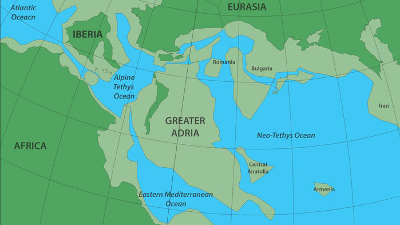|
Study Traces Fate of Ancient Continent Now Underneath Europe
September 11, 2019
Scientists have recreated what happened to a large continent that is now underneath southern Europe. Greater Adria, as it is known, broke off some 240 million years ago from Gondwanaland, a very large landmass that contained what is now Africa, Antarctica, Australia, South America, the Arabian Peninsula, and the Indian subcontinent. At the time, Greater Adria stretched from what is now Spain to what is now Iran but, because most of it was underwater, was more likely to have been a number of islands or archipelagos than a continuous landmass–above water, anyway. The lands were closer together in those days, but Greater Adria was still large, the size of Greenland today. Researchers, led by Utrecht University's Douwe van Hinsbergen, have found limestone rocks from the ancient continent in dozens of countries. Those rocks were the result of a tectonic collision about 100 million years ago between Greater Adria, part of the African tectonic plate, and the European tectonic plate. The collision was slow but steady and drove Greater Adria underneath the European plate. Van Hinsbergen and his Dutch colleagues spent a decade studying rock samples from the area and combing through the direction of magnetic fields trapped within the rocks; both the makeup of the rocks and the presence of a magnetic field convinced the researchers that they had found the remnants of the submerged continent. They have also released a map of what the continent would have looked like all those years ago; more significantly, they have also constructed a time-elapse collection of images of the evolution of the landmass. The study is reminiscent of a pair of similar announcements in 2017, of Mauritia, a supercontinent that once included what is now both India and Madagascar, and of Zealandia, a 2-million-square-mile underwater landmass that includes both New Caledonia and New Zealand, which are 1,500 miles apart. Both of these large landmasses were also once part of Gondwanaland, which itself predated then formed part of the supercontinent Pangaea. Subsequent breakups of the very large landmasses, coupled with an ice age or two, resulted in the formation of today's continents. |
Social Studies for Kids |
Social Studies for Kids
copyright 2002–2024
David White





